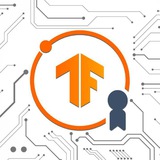Applied Causal Inference Powered by ML and AI, 2024.pdf
15.3 MB
Applied Causal Inference Powered by ML and AI
Victor Chernozhukov, 2024
Victor Chernozhukov, 2024
👍9🔥1
Artificial Intelligence and Chatbots 101 (2024).pdf
1.3 MB
📚 Title: Artificial Intelligence and Chatbots 101 (2024)
Join for more: https://t.me/machinelearning_deeplearning
Join for more: https://t.me/machinelearning_deeplearning
👍9❤1🔥1
Artificial Intelligence for Robotics, 2024.pdf
36.6 MB
Artificial Intelligence for Robotics
Francis X. Govers III, 2024
Francis X. Govers III, 2024
Medical Robotics. History, Challenges, 2024.pdf
7.3 MB
Medical Robotics
Yao Guo, 2023
Yao Guo, 2023
Topalian JavaScript Robot AI, 2023.pdf
6.9 MB
Topalian JavaScript Robot AI
Christopher Andrew Topalian, 2023
Christopher Andrew Topalian, 2023
👍8❤1🔥1
Build Your Own Robot Using Python... 2024.pdf
12.2 MB
Build Your Own Robot
Marwan Alsabbagh, 2024
Marwan Alsabbagh, 2024
👍8🔥1
Supervised_Machine_Learning_for_Text_Analysis_in_R_Emil_Hvitfeldt.pdf
16 MB
Supervised Machine Learning for Text Analysis in R
Emil Hvitfeldt, 2022
Emil Hvitfeldt, 2022
👍4🔥1
TOP 10 Python Concepts for Job Interview
1. Reading data from file/table
2. Writing data to file/table
3. Data Types
4. Function
5. Data Preprocessing (numpy/pandas)
6. Data Visualisation (Matplotlib/seaborn/bokeh)
7. Machine Learning (sklearn)
8. Deep Learning (Tensorflow/Keras/PyTorch)
9. Distributed Processing (PySpark)
10. Functional and Object Oriented Programming
Join for more: https://t.me/dsabooks
1. Reading data from file/table
2. Writing data to file/table
3. Data Types
4. Function
5. Data Preprocessing (numpy/pandas)
6. Data Visualisation (Matplotlib/seaborn/bokeh)
7. Machine Learning (sklearn)
8. Deep Learning (Tensorflow/Keras/PyTorch)
9. Distributed Processing (PySpark)
10. Functional and Object Oriented Programming
Join for more: https://t.me/dsabooks
👍8
Neural Networks and Deep Learning
Neural networks and deep learning are integral parts of artificial intelligence (AI) and machine learning (ML). Here's an overview:
1.Neural Networks: Neural networks are computational models inspired by the human brain's structure and functioning. They consist of interconnected nodes (neurons) organized in layers: input layer, hidden layers, and output layer.
Each neuron receives input, processes it through an activation function, and passes the output to the next layer. Neurons in subsequent layers perform more complex computations based on previous layers' outputs.
Neural networks learn by adjusting weights and biases associated with connections between neurons through a process called training. This is typically done using optimization techniques like gradient descent and backpropagation.
2.Deep Learning : Deep learning is a subset of ML that uses neural networks with multiple layers (hence the term "deep"), allowing them to learn hierarchical representations of data.
These networks can automatically discover patterns, features, and representations in raw data, making them powerful for tasks like image recognition, natural language processing (NLP), speech recognition, and more.
Deep learning architectures such as Convolutional Neural Networks (CNNs), Recurrent Neural Networks (RNNs), Long Short-Term Memory networks (LSTMs), and Transformer models have demonstrated exceptional performance in various domains.
3.Applications Computer Vision: Object detection, image classification, facial recognition, etc., leveraging CNNs.
Natural Language Processing (NLP) Language translation, sentiment analysis, chatbots, etc., utilizing RNNs, LSTMs, and Transformers.
Speech Recognition: Speech-to-text systems using deep neural networks.
4.Challenges and Advancements: Training deep neural networks often requires large amounts of data and computational resources. Techniques like transfer learning, regularization, and optimization algorithms aim to address these challenges.
LAdvancements in hardware (GPUs, TPUs), algorithms (improved architectures like GANs - Generative Adversarial Networks), and techniques (attention mechanisms) have significantly contributed to the success of deep learning.
5. Frameworks and Libraries: There are various open-source libraries and frameworks (TensorFlow, PyTorch, Keras, etc.) that provide tools and APIs for building, training, and deploying neural networks and deep learning models.
Join for more: https://t.me/machinelearning_deeplearning
Neural networks and deep learning are integral parts of artificial intelligence (AI) and machine learning (ML). Here's an overview:
1.Neural Networks: Neural networks are computational models inspired by the human brain's structure and functioning. They consist of interconnected nodes (neurons) organized in layers: input layer, hidden layers, and output layer.
Each neuron receives input, processes it through an activation function, and passes the output to the next layer. Neurons in subsequent layers perform more complex computations based on previous layers' outputs.
Neural networks learn by adjusting weights and biases associated with connections between neurons through a process called training. This is typically done using optimization techniques like gradient descent and backpropagation.
2.Deep Learning : Deep learning is a subset of ML that uses neural networks with multiple layers (hence the term "deep"), allowing them to learn hierarchical representations of data.
These networks can automatically discover patterns, features, and representations in raw data, making them powerful for tasks like image recognition, natural language processing (NLP), speech recognition, and more.
Deep learning architectures such as Convolutional Neural Networks (CNNs), Recurrent Neural Networks (RNNs), Long Short-Term Memory networks (LSTMs), and Transformer models have demonstrated exceptional performance in various domains.
3.Applications Computer Vision: Object detection, image classification, facial recognition, etc., leveraging CNNs.
Natural Language Processing (NLP) Language translation, sentiment analysis, chatbots, etc., utilizing RNNs, LSTMs, and Transformers.
Speech Recognition: Speech-to-text systems using deep neural networks.
4.Challenges and Advancements: Training deep neural networks often requires large amounts of data and computational resources. Techniques like transfer learning, regularization, and optimization algorithms aim to address these challenges.
LAdvancements in hardware (GPUs, TPUs), algorithms (improved architectures like GANs - Generative Adversarial Networks), and techniques (attention mechanisms) have significantly contributed to the success of deep learning.
5. Frameworks and Libraries: There are various open-source libraries and frameworks (TensorFlow, PyTorch, Keras, etc.) that provide tools and APIs for building, training, and deploying neural networks and deep learning models.
Join for more: https://t.me/machinelearning_deeplearning
Telegram
Artificial Intelligence
🔰 Machine Learning & Artificial Intelligence Free Resources
🔰 Learn Data Science, Deep Learning, Python with Tensorflow, Keras & many more
For Promotions: @love_data
🔰 Learn Data Science, Deep Learning, Python with Tensorflow, Keras & many more
For Promotions: @love_data
👍10❤5
